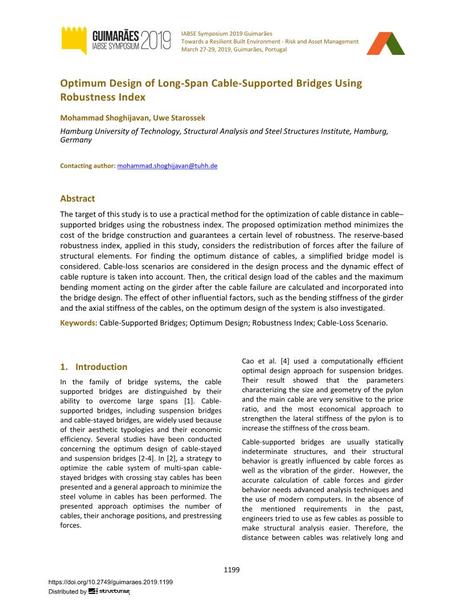Optimum Design of Long-Span Cable-Supported Bridges Using Robustness Index

|
|
|||||||||||
Bibliografische Angaben
| Autor(en): |
Mohammad Shoghijavan
(Hamburg University of Technology, Structural Analysis and Steel Structures Institute, Hamburg, Germany)
Uwe Starossek |
||||
|---|---|---|---|---|---|
| Medium: | Tagungsbeitrag | ||||
| Sprache(n): | Englisch | ||||
| Tagung: | IABSE Symposium: Towards a Resilient Built Environment Risk and Asset Management, Guimarães, Portugal, 27-29 March 2019 | ||||
| Veröffentlicht in: | IABSE Symposium Guimarães 2019 | ||||
|
|||||
| Seite(n): | 1199-1206 | ||||
| Anzahl der Seiten (im PDF): | 8 | ||||
| DOI: | 10.2749/guimaraes.2019.1199 | ||||
| Abstrakt: |
The target of this study is to use a practical method for the optimization of cable distance in cable– supported bridges using the robustness index. The proposed optimization method minimizes the cost of the bridge construction and guarantees a certain level of robustness. The reserve-based robustness index, applied in this study, considers the redistribution of forces after the failure of structural elements. For finding the optimum distance of cables, a simplified bridge model is considered. Cable-loss scenarios are considered in the design process and the dynamic effect of cable rupture is taken into account. Then, the critical design load of the cables and the maximum bending moment acting on the girder after the cable failure are calculated and incorporated into the bridge design. The effect of other influential factors, such as the bending stiffness of the girder and the axial stiffness of the cables, on the optimum design of the system is also investigated. |
||||
